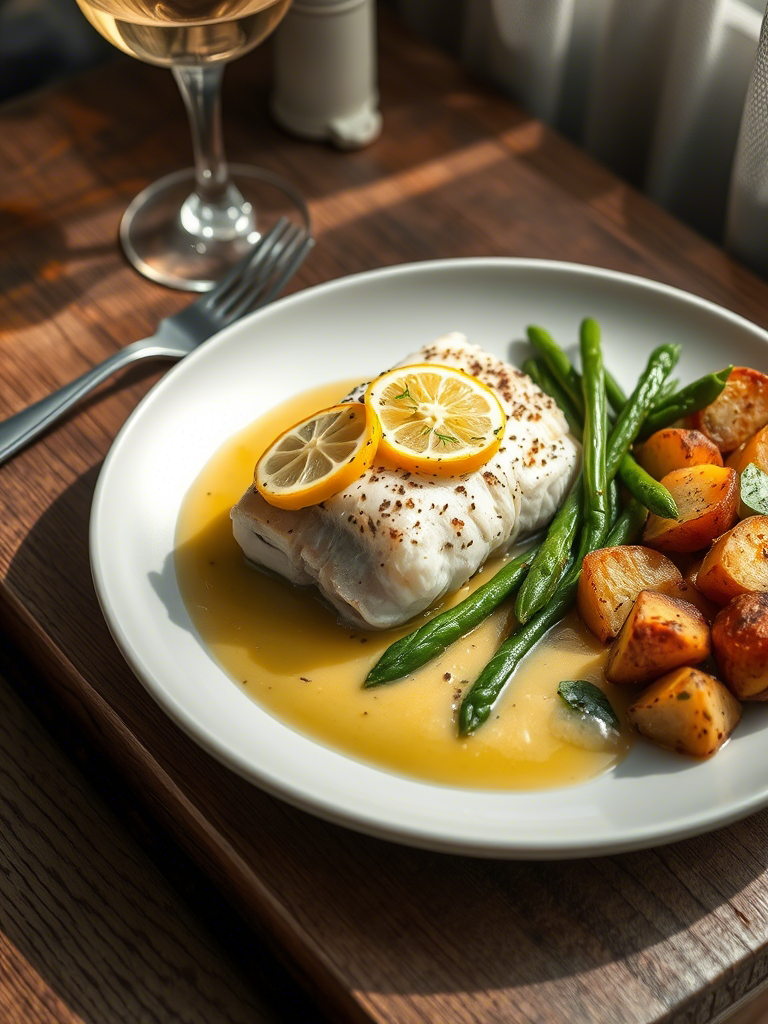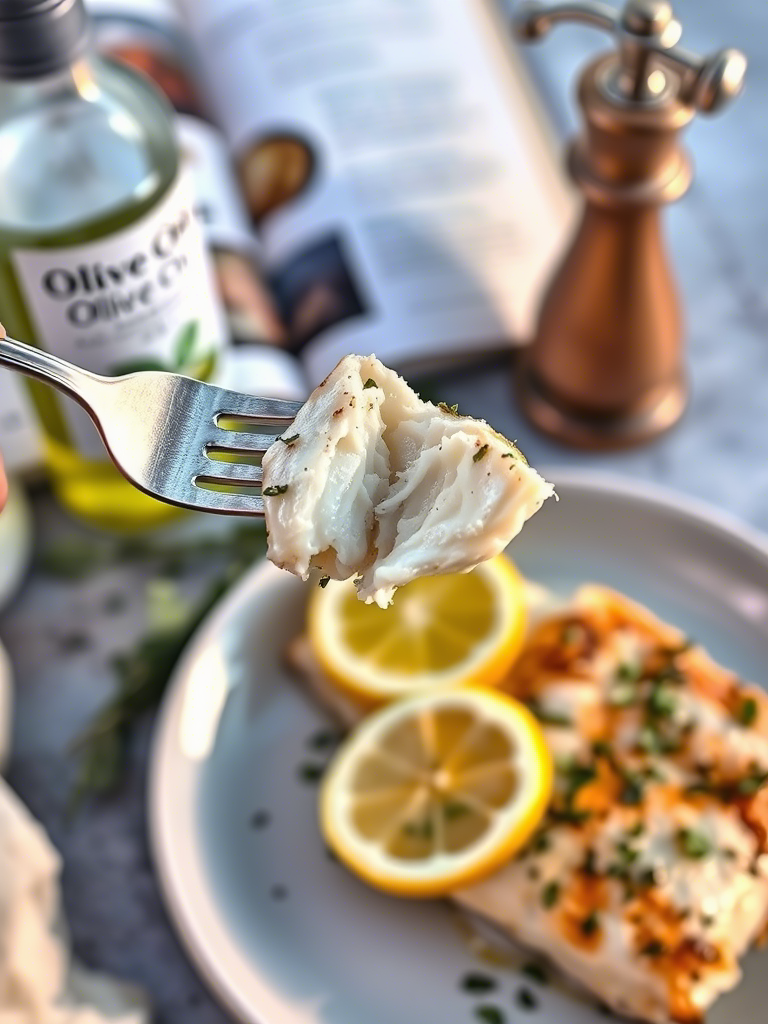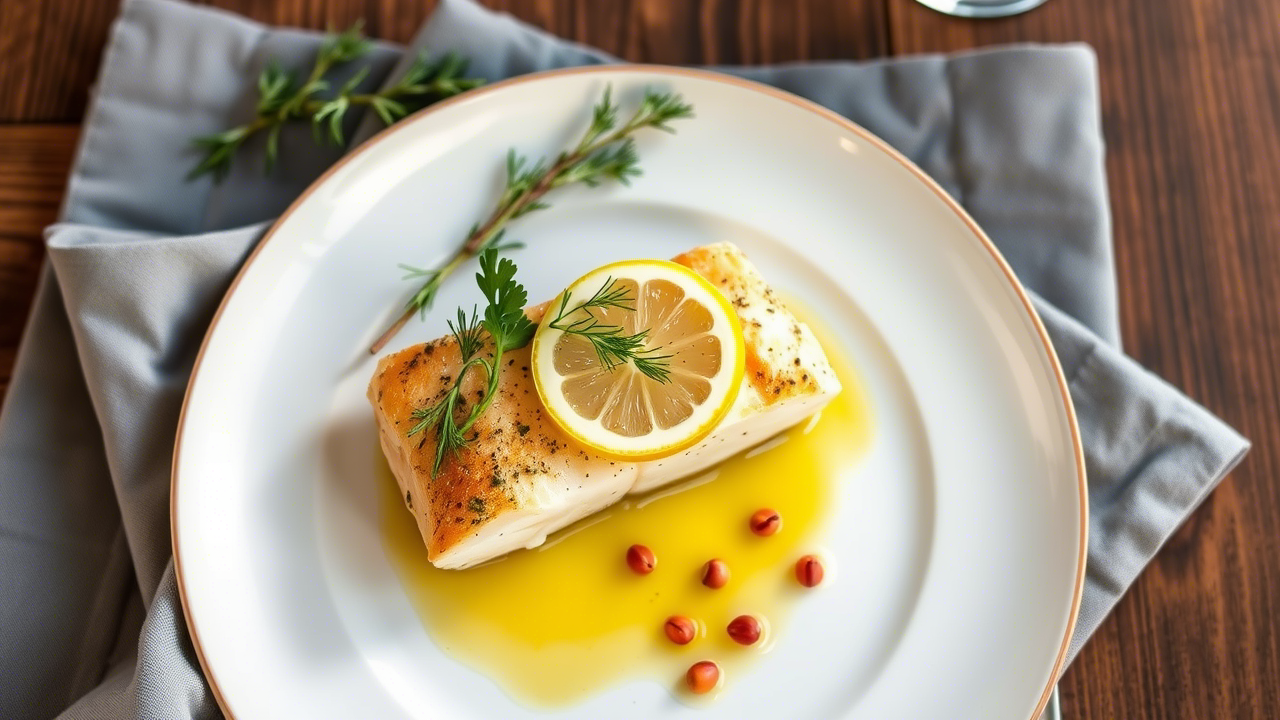You’d think cod was boring. Just a white, flaky fish sitting quietly in the back of the seafood case, right? But give it lemon. Give it herbs. Bake it gently, not with aggression but with intention—and suddenly, you’ve got yourself a plate of pure elegance. This isn’t about overcomplication. This is about precision, respect for the ingredient, and letting the fish whisper instead of scream.
In this deep dive, we’re exploring the how and the why behind Lemon-Herb Baked Cod. This isn’t your average weeknight dinner blog fluff. It’s a layered, expert-level look at technique, sourcing, flavor chemistry, and the art of restraint. Cod doesn’t beg for fuss. It demands clarity.
Let’s get our hands in the citrus.
Why Cod? Why Baked? Why Lemon?
Let’s clear something up first: cod is not a fallback fish.
It’s a canvas.
North Atlantic cod (Gadus morhua) is prized for its lean meat, mild flavor, and large flake. It’s versatile, forgiving to work with, but when handled with care, it’s downright sublime.
Baking preserves its moisture far better than pan-frying, especially when paired with acidity and aromatics. Lemon and herbs do more than flavor the surface—they infuse, thanks to steam and fat carrying volatile compounds into the flesh.
And lemon, well. Lemon’s essential oils in the zest cut through any marine note lingering on the finish. The juice softens proteins without cooking them, unlike vinegar. It’s bright without being loud. Zesty without being obnoxious. People overuse garlic. Underuse lemon.
Sourcing Cod: Not All Fillets Are Equal
Before you preheat the oven, get serious about your fish.
Wild-caught North Atlantic cod is the gold standard. Look for certifications: MSC (Marine Stewardship Council) ensures sustainable sourcing. Avoid anything that looks too white—it’s often water-logged. Fresh cod should look slightly translucent, not dry and chalky.
If you’re in the Midwest or inland, frozen is your reality—and that’s not a bad thing. IQF (individually quick frozen) cod, especially Norwegian, maintains integrity when thawed slowly in the fridge. Don’t rush it. Let the fish breathe its way back.
Farmed cod exists, yes. It’s a bit fattier and slightly less flaky. Not inherently worse, but expect a different texture profile. More like sablefish in the mouth.

Flavor Matrix: Herbs, Citrus, and Lipids
Here’s where professionals separate themselves from Pinterest-level home cooks.
Lemon juice and zest. Fresh, not bottled. Zest contains limonene and citral—aromatics that unlock with heat. Juice brings malic and citric acids which tenderize proteins subtly.
Herbs: Use a combo of hard and soft. Thyme (especially lemon thyme), rosemary (sparingly), and parsley or chervil for brightness. Dill? Works, but can overpower if you get heavy-handed. Basil? Too soft for baking—saves its drama for pesto.
Fat is non-negotiable. Olive oil? Of course. But if you want to edge it up: brown butter. Just a little. Butter infused with garlic and thyme, browned until nutty, gives a deep counterpoint to cod’s leanness.
And salt? Diamond Crystal kosher if you’re in the U.S. Flake salt at finish only. Never iodized. Just… don’t.
Technique That Honors the Fish
Preheat your oven to 400°F (204°C). No lower. Low heat makes cod weep. High heat firms it fast, locking in that delicate moisture.
Line a rimmed baking sheet with parchment. Don’t use foil—it reflects heat unevenly. Smear a little oil underneath the fillet so it doesn’t stick. Cod is polite, but clingy.
Pat cod fillets dry. Season both sides. Add lemon zest directly to the surface. Let it sit 10 minutes, uncovered, to temper. Cold fish into a hot oven? Never ends well. You want surface dryness to encourage slight Maillard. Yes, even in a low-sugar fish.
Lay herbs under and on top. This isn’t just seasoning—this is insulation. Herbs beneath steam into the flesh. Ones on top dry-fry, giving aromatic lift.
Bake for 12–15 minutes max. Internal temp should hit 130–135°F (54–57°C). Rest 2–3 minutes before serving. Fish keeps cooking even after leaving the oven. Let it.
And never cover with foil to keep warm. That’s a crime. You’re steaming it into oblivion.
Plating with Purpose
Plate cod with intent, not chaos.
Use a shallow rimmed plate to catch juices. Spoon over the baking pan drippings—liquid gold with herbal punch. Don’t drown it in a sauce. It’s baked, not braised.
Serve with contrast. Think: a fennel-orange salad. Roasted potatoes smashed with sea salt. Sautéed Swiss chard with lemon zest and chili flake.
Or go bold: preserved lemon salsa, or a green sauce made with parsley, anchovy, capers, and lemon. You want acid on acid, but balanced. Not pucker-inducing.

Science Behind the Simplicity
Let’s get chemical, yeah?
Cod’s muscle structure is made of short myotomes with delicate connective tissue. Unlike salmon, cod flakes with a whisper because its collagen breaks down faster at lower temps. That’s why overcooked cod goes stringy. You’ve broken its beautiful structure.
Lemon juice, used sparingly, denatures surface proteins—giving a soft, almost velvety mouthfeel. Not quite ceviche, but moving that way.
The fat layer from olive oil or butter acts as a medium for oil-soluble flavors. Rosemary and thyme release terpenes and camphor-like compounds that dissolve best in fat, not water. That means without fat? You’re just steaming herbs.
Zest unlocks essential oils when heated. Cold zest is nice. But warm? It’s another level of volatile complexity.
Addressing Misconceptions
“Cod is bland.”
Wrong. Cod is subtle. You don’t call silk boring because it doesn’t shout. You appreciate its texture, its drape. Cod, properly treated, is the same. Let the aromatics lift it, not mask it.
“You have to bread it.”
Not here. Breading cod is for frying. For baking, it’s an unnecessary barrier. It blocks absorption of aromatics and traps moisture unevenly. That’s fish stick territory.
“It falls apart when cooked.”
Only when overcooked. Or when it’s poor quality. Or handled wrong. Or rushed. Good cod, cooked just right, flakes clean and holds shape.
Emerging Trends in Cod Cooking
We’re seeing chefs push boundaries.
Curing cod lightly before baking. A 30-minute salt-cure tightens the proteins and seasons deeper.
Infusing olive oil with lemon peel, coriander, and fennel seed, then baking cod submerged. A technique borrowed from confit, minus the fat overload.
Or pairing cod with fermented elements—lemon kosho, pickled green tomatoes, miso butter. It’s subtle vs. umami, a beautiful tension.
Even smoked salt finishes—adds dimension without heat. Smoked Maldon or Alderwood sea salt can mimic a wood-fired bake.
Cod for the Professional Menu
Lemon-Herb Baked Cod is kitchen gold for restaurant pros.
Low food cost. High perceived value. Fast fire time. Holds well on a pass.
Plays well with seasonal sides. Easy to batch prep. And gluten-free without effort. Customers love it. Kitchens love it more.
One NYC chef I know bakes cod over thin-sliced lemons on cedar planks, then flash-broils for 30 seconds. Adds a touch of smoke. Zero flare-up risk. Guests think it’s revolutionary. It’s just cod done thoughtfully.
Wrapping It Up: The Cod Truth
Cod isn’t the star of a circus. It’s the soloist in a chamber orchestra.
Lemon-Herb Baked Cod, done right, is a study in subtlety and precision. It’s restraint with intention. A dish that leans on good sourcing, sharp technique, and respect for flavor chemistry.
You don’t need fancy gear. You don’t need to sous-vide it into submission. Just buy good cod. Use fresh lemon. Bake like you mean it.
Don’t overthink the fish. Just think carefully.
And remember: the best dishes rarely scream. They hum.
If you’re building a menu—or just feeding someone you care about—this is one fish worth doing justice.
FAQs
What kind of cod is best for Lemon-Herb Baked Cod?
Wild-caught North Atlantic cod is the best choice for flavor and texture.
Can I use frozen cod for this recipe?
Yes, just make sure it’s high-quality IQF cod and thaw it slowly in the fridge.
What temperature should I bake cod at?
Bake at 400°F (204°C) for the best moisture and texture balance.
How long should I bake cod?
About 12–15 minutes, or until it reaches 130–135°F internally.
Should I cover the cod while baking?
No, covering traps steam and ruins the flaky texture.
What herbs work best with lemon and cod?
Thyme, parsley, chervil, and a bit of rosemary balance beautifully with lemon.
Can I substitute lemon with another citrus?
You can use lime or orange, but lemon delivers the best acidity and aromatic profile.
Why not use foil on the baking tray?
Foil reflects heat unevenly—parchment gives more consistent cooking.
How do I know when cod is perfectly cooked?
It flakes easily with a fork and looks opaque but still moist.
Is this recipe gluten-free?
Yes, it’s naturally gluten-free with no breading or flour.
What sides go best with Lemon-Herb Baked Cod?
Try roasted potatoes, fennel-orange salad, or sautéed greens for balance.
Can I meal prep this dish ahead of time?
You can season and prep the fish ahead, but bake fresh for best results.
Is this dish restaurant-friendly?
Absolutely—it’s cost-effective, quick to fire, and high on presentation value.
What’s the main mistake to avoid?
Overcooking—cod becomes dry and stringy if it goes past 135°F.
Do I need to marinate the cod in lemon juice?
No, just a brief rest with zest and seasoning is enough—juice can toughen the fish if used too early.

Mariana is a passionate home cook who creates delicious, easy-to-follow recipes for busy people. From energizing breakfasts to satisfying dinners and indulgent desserts, her dishes are designed to fuel both your body and hustle.
When she’s not in the kitchen, she’s exploring new flavors and dreaming up her next recipe to share with the Foodie Hustle community.

